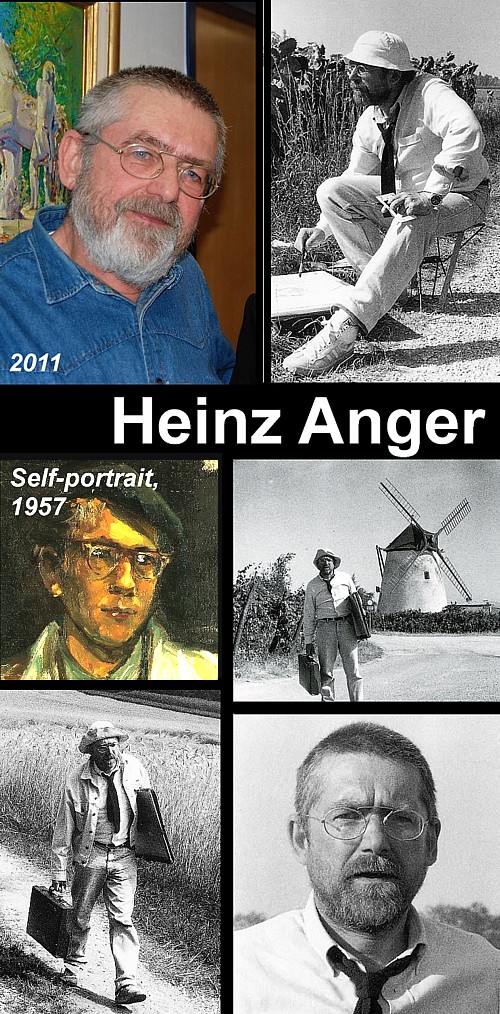 |
| Santa Maria della Salute with Customs, 1999, Heinz Anger |
One of my favorite painting mediums is watercolor. I suppose that's because I never did enough of them in college (and virtually none since) to really get very good at it. I'd go back and try some more now in my old age but I'd have to go buy a whole new array of colors, which would cost a fortune, and probably benefit me very little. On top of that, to frame watercolors under glass for display would cost a second fortune. Inasmuch as I have only one fortune (and a rather meager one at that), I guess I'll stick to my beloved acrylics. Moreover, I sometimes find myself using them in a thin, transparent manner not unlike watercolor. In my book, Art THINK (available at right), if I might quote myself, I made the statement that, "Acrylics make better watercolors than watercolors." That is to say, they're more durable, less fragile, and depending upon how they're used, can be made to appear virtually indistinguishable from watercolors. In any case, I recently came upon the work of an Austrian painter who, though he also paints with oils, has mastered the cantankerous medium of watercolor to an incredible degree (he makes it look easy). His name is Heinz Anger (pronounced like "hunger" but without the "h."
 |
| Winter watercolors. Beautiful as they are, I'd never sit out in the blustery cold and paint...not in a million years. |
I am doubly in love with this man's work in that I love to see snow scenes painted in watercolor (above). What a chore that must be to sit out in the cold (Anger paints on location as do many watercolor painters) and try desperately to keep your fingers from freezing faster than your water. I've painted many snow scenes in my life, but always from photos and never in watercolor. And if you think Anger's winter scenes are spectacular, look below at what he does on summer vacations in Venice, Italy, another venue I like very much. His Santa Maria della Salute with Customs (top), from 1999, is a tour de force in handling difficult subjects (architecture and water) using a very difficult medium.
Heinz Anger was born in 1941 near Karlstetten, (Lower) Austria, though he grew up Favoriten, a district of Vienna, Austria. In 1955 he started his art studies at the Graphische Leh-rund Versuchsanstalt ("Die Graphische"), the college for graphics and media in Vienna. Upon graduating, Anger continued his studies at the Academy of Fine Arts in Vienna. After leaving the academy Anger embarked upon a career as a graphic artist before moving on to become a freelance illustrator working for leading marketing agencies. In search of his own style, Anger was influenced by different movements during the following years. His 1960s’ paintings reflected the spirit of the Vienna School of Fantastic Realism. From 1970 he created a series of panels and drawings in a kind of Austrian Pop Art. By 1979 Anger had gradually developed a painting style he now considers his own, managing the transition from graphic artist to full-time painter.
 |
| Heinz Anger on the road. Does anyone still wear a necktie when painting...or paint without an easel? |
Anger uses a symbols in his work such as strong, ancient trees, deeply rooted and in their environment, representing long life and the wisdom of old age. Yet on the other side we see emerging tender new growth, symbolizing a light-headed, still insecure youth. Anger never intended to conform with Modern Art; but instead tries to rejuvenate his work by referring back to a primordial nature. His art is unmistakable instantly recognizable through his use of light, his application of colors, and the striking yellows, rich blues and violets, leading to a boldness in his choice of motifs the combination of an atmospheric pond and the bright sun for example. Heinz Anger's wife, Helga, is also an artist. They have two children and a grandchild (below) all of whom get drawn and painted from time to time.
 |
| Anger is an excellent expressionist portrait artist. |
Heinz Anger's works in oils we might easily categorize as 21st-century Impressionism with subjects reflecting a period of broad travels in his youth and travels abroad during his senior years. In his search for truth in nature the artist is approaching Waldmüller's ideals of imagery. However, in his impressionist symbolism he is close to van Gogh, Klimt and also Franz Wiegele.
 |
| Ernstbrunn Castle, 2008, Heinz Anger |
 |
| Windmill of Retz, 1989, Heinz Anger |

No comments:
Post a Comment